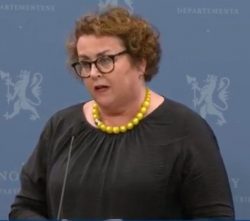Norway’s deeply troubled Christian Democrats Party became a shadow of its former self in the recent election, winning just 3.8 percent of the vote and only three seats in Parliament. The party may, however, find that a new Labour-Center government can be an interesting partner and path to revival.

The Christian Democrats, under former leader Knut Arild Hareide, nearly toppled now-outgoing Prime Minister Erna Solberg’s conservative coalition in 2018. Hareide, provoked by Solberg’s right-wing partner the Progress Party, openly wanted to cooperate with Jonas Gahr Støre’s Labour Party instead of Solberg’s side. Støre himself is generally more conservative than earlier Labour leaders have been, and Christian as well. Støre’s wife, Marit Slagsvold, was even recently ordained as a pastor in the Norwegian Church. Hareide argued mostly, however, that the two parties’ politics and values were more in line with one another.
Amidst a dramatic split within the Christian Democrats, though, they ended up sticking with Solberg and actually joining her government. Hareide lost his leadership role to Kjell Ingolf Ropstad and the party stayed on the conservative side of Norwegian politics.
Now Ropstad has himself fallen from grace, resigning on September 20 as both the Christian Democrats’ leader and from his already-short-lived ministerial post after he was found to have exploited the Parliament’s generous commuter housing benefit and actively tried to cut his own tax bill. Ropstad basically lived at taxpayers’ expense for more than 10 years, and simply apologizing for that wasn’t enough.
Ropstad’s offenses couldn’t have come at a worse time for the Christian Democrats, which once held the prime minister’s post in earlier government coalitions. With media reports flying about Ropstad’s role in what’s become an ever-growing scandal over politicians’ benefits and compensation, his party didn’t even win enough voter support to qualify for full representation in Parliament. By falling below the important 4 percent mark, their number of seats in Parliament fell from 10 in 2013 to just three heading into the new session.
Ropstad had already been among the three Christian Democrats elected to Parliament on September 11, though, so he’ll keep his seat. The party must, however, elect a new leader, bound to be one of its two others holding a seat in Parliament: Olaug Bollestad or Dag Inge Ulstein.
With the party itself down in the dumps, and even written off as irrelevant by several political commentators, debate over its future and profile in Norwegian politicis has risen. Newspaper Aftenposten editorialized that the party is in its worst crisis ever: “Strangely enough, it seems the Christian Democrats lack any meaning in life.” Newspaper Klassekampen also noted that not only does the party need to find a new leader, “it needs to find itself.”
Young party members favour Ulstein as a new leader who could expand interest in the party beyond its “Bible belt” territory in southwestern Norway. Ulstein is from the Bergen area, north of the Agder/Rogaland regions where most of the Christian Democrats’ traditional constituency lives.

PHOTO: Regjeringen
That’s what’s suddenly putting the party in play. Shifting from the conservative side to the left-center side could revive its fortunes. It could also be more pragmatic, since the Christian Democrats back the Center Party’s core issues like agriculture subsidy and support for outlying districts. The Christian Democrats also aren’t quite as “Christian” as some other newer, smaller and far more conservative parties like De Kristne. Commentator Helge Simonnes noted how De Kristne grabbed 0.4 percent of the vote, “not much, but enough to push the Christian Democrats under the limit for full representation in Parliament.”
Few argue that the party needs to be modernized. Either a shift to the left-center side or reinforcement of its traditional centrist role may help. “It will be important for the party in opposition to have its own profile and not be part of either the right- or the left side,” Ida Lindtveit Røse, who took over Ropstad’s ministerial role when he was out on paternity leave in May 2020.
At the very least, a new profile could help make the party more relevant again prior to the next election in 2025. After SV pulled out of left-center government talks, Labour and Center will need all the support they can get in Parliament to form a majority.
newsinenglish.no/Nina Berglund

